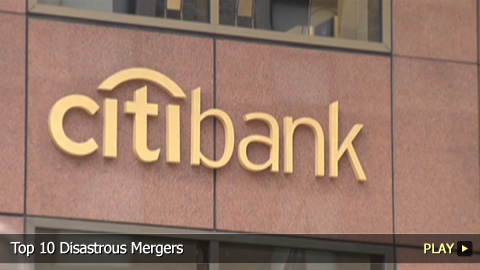Top 10 Disastrous Mergers

- �� Excite and @Home (1999) - ± $6.7 billion
- �� New York Central and Pennsylvania Railroads (1968) - ± $6.5 billion
- �� Kmart and Sears (2005) - ± $11 billion
- �� Alcatel and Lucent (2006) - ± $13.4 billion
- �� CBS and Viacom (2000) - ± $35.6 billion
- �� Sprint and Nextel (2005) - ± $36 billion
- �� Citicorp and Travelers Group (1999) - ± $140 billion
- �� Daimler Benz and Chrysler (1998) - ± $36 billion
- �� Seagram and Vivendi Universal (2000) - ± $34 billion
- �� AOL and Time Warner (2001) - ± $164 billion
#10 – Excite and @Home (1999) - ± $6.7 billion
With their shared VC firm, Kleiner Perkins, concerned about increasing competition, the high-speed cable internet services of the @Home Network were combined with Excite’s popular search engine in the hopes of attracting millions of subscribers. The resulting $6.7-billion Excite@Home deal was one of history’s biggest mergers involving two Internet companies; but the NASDAQ’s systematic meltdown and the culture clash between Excite’s dot-com bubble and @Home’s more corporate and conservative cable business ultimately led to its demise.
#9 – New York Central and Pennsylvania Railroads (1968) - ± $6.5 billion
This unlikely merger of two rival railroad companies was their attempt to remain relevant alongside the booming auto industry. Though Penn Central became one of the United States’ biggest corporations, the company couldn’t survive inflation, internal conflicts, bad management and massive cost cutting. A promised $200-million government loan never materialized, and in 1970 Penn Central filed for the biggest corporate bankruptcy to that point.
#8 – Kmart and Sears (2005) - ± $11 billion
It was businessman and investor Edward Lampert who united the struggling department store chain with the struggling discount store chain. Unfortunately, both Sears and Kmart continued to fail as Sears Holdings, with the subsequent recession uncovering problems like poor investment and shrinking revenues. To make matters worse, the higher prices of the company’s goods increased its irrelevance against retail giants like Walmart.
#7 – Alcatel and Lucent (2006) - ± $13.4 billion
To keep up with the ever-growing telecommunications industry, the networking technologies of American multinational Lucent were joined with French company Alcatel. However, the $13-billion-plus deal did more damage than good: as revenues decreased, the two cultures found little common ground and few lasting solutions. Within a few years, higher-ups at Alcatel-Lucent resigned, losses totaled in the millions and the value of Lucent’s Alcatel-purchased assets plummeted.
#6 – CBS and Viacom (2000) - ± $35.6 billion
Described by CNN as an attempt to make Dan Rather’s network relevant to the MTV generation, this merger instead caused stock prices to decline and executives to feud. Calling it a disaster is slightly unfair; but, considering the over-$35-billion deal between the entertainment conglomerate and the broadcaster was the largest in media at the time, and that they split just a few years later – well, that’s all you need to know.
#5 – Sprint and Nextel (2005) - ± $36 billion
This merger of equals paired a telecommunications company with a wireless service provider for a mere $36-billion. However, Sprint’s poor customer service soon tainted Nextel’s excellent rep, and, along with incompatible networks, this dashed hopes for a bigger subscriber base and improved operations. As management and customers began leaving, the company’s shares collapsed drastically, and in 2008 Sprint Nextel wrote down $30- of the $36-billion merger.
#4 – Citicorp and Travelers Group (1999) - ± $140 billion
When these companies came together in a $70-billion deal, the banking giant and the financial conglomerate thought they had a surefire way to increase customers and investors. But the Citigroup merger felt more like a takeover when Travelers Group bought all Citicorp shares and dismissed its highest-ranking officers. This lack of synergy forced Citigroup to later turn the Travelers insurance division into a separate business.
#3 – Daimler Benz and Chrysler (1998) - ± $36 billion
One of history’s biggest industrial mergers paired German car manufacturer Benz AG with American automaker Chrysler Corporation for over $36-billion. Though dubbed a merger of equals, the Daimler Chrysler partnership found little success mixing luxury and budget-friendly cars and European and American cultures. After sales and stock prices dropped significantly, Chrysler was sold to an American private equity firm.
#2 – Seagram and Vivendi Universal (2000) - ± $34 billion
Once it made its billions as a distillery, the Seagram Company began acquiring businesses like Universal Studios. After several losses, CEO Edgar Bronfman, Jr. agreed to merge with a French media company to form Vivendi Universal Entertainment. Less than two years later, the company lost $30-billion and was selling non-strategic assets, while the Bronfmans experienced one of the biggest losses by a single family ever.
#1 – AOL and Time Warner (2001) - ± $164 billion
It’s been called the worst merger ever and the single biggest mistake in corporate history. After Time Warner merged its old-school print media with AOL’s new-school digital content for $164-billion, the dot-com bubble burst. Add AOL’s reliance on dial-up Internet in an increasingly high-speed industry, and AOL Time Warner was reporting a $99-billion loss in 2002. A rapidly declining stock price and millions in lost jobs and subscribers forced Time Warner to spin AOL off into an independent company seven years later.
Do you agree with our list? Which do you think it was the most disastrous merger ever? Be sure to subscribe to WatchMojo.com for more entertaining top 10s.
